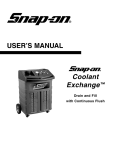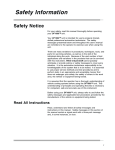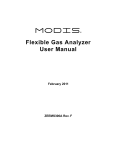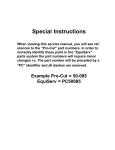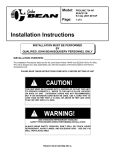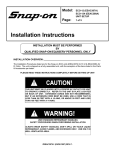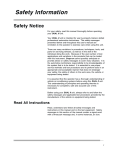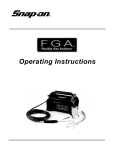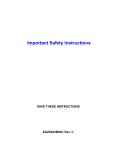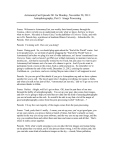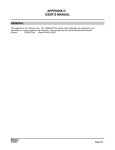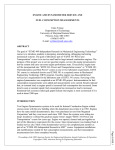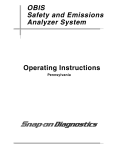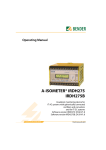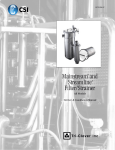Download here - Snap-on Equipment
Transcript
SUN ® USER’S MANUAL Sun Coolant Exchange™ Drain and Fill with Continuous Flush Sun Coolant Exchange™ User’s Manual Table of Contents Safety ................................................ 2 Introduction ...................................... 5 Functional Description .............................. Front Panel ........................................ Back Panel ........................................ Control Panel ...................................... Accessories ........................................ Control Panel Key Terms .................... Specifications .......................................... 5 5 6 6 6 7 7 Installation and Operation .............. 7 Testing Tips ........................................ 7 Valve Position Chart ................................ 8 Preparing Vehicle for Service .................. 10 Pressure Test .......................................... 10 Drain and Fill .......................................... 11 Continuous Flush .................................... 13 Power Drain Recovery Tank .................... 14 Recycle Used Coolant from Recovery Tank ...................................................... 14 Maintenance .................................... 14 Recovery Hose Strainer ............................ Cleaning Recovery Hose Strainer .......... Changing Filter Cartridges on Optional Recycler Hit ............................ Replacement Parts ................................ Optional Accessories ........................ Troubleshooting ...................................... 14 15 Trademark Acknowledgements Snap-on® is a registered trademark of Snap-on Technologies, Inc. (USA and Canada) EquiServ® is a registered trademark of Snap-on Tools Company. (USA) EquiServ® is a registered trademark of Snap-on Technologies, Inc. (Canada) Sun Coolant Exchange™ is a trademark of Snap-on Technologies, Inc. (USA and Canada) Copyright Information Sun Coolant Exchange™ User’s Manual ©2002 Snap-on Technologies, Inc. The information, specifications and illustrations in this manual are based on the latest information available at the time of printing. Snap-on Technologies, Inc. reserves the right to make changes at any time without notice. 15 16 16 17 Table of Illustrations Introduction Figure 1: Front Panel .............................. 5 Figure 2: Back Panel .............................. 6 Figure 3: Control Panel ............................6 Figure 4: Sun Coolant Exchange™ Accessories .............................................. 6 Installation and Operation Figure 5: Recovery Hose and Adapter Attached to Radiator .............................. 10 Figure 6: Supply Hose and Adapter Attached to Engine ................................ 10 Table 1: Cooling System Pressure Ranges .................................................. 11 Maintenance Figure 7: Strainer Assembly .................. 15 1 Safety Information Safety Information Safety Notice For your safety, read this manual thoroughly before operating your Sun Coolant Exchange™ unit. Your Sun Coolant Exchange™ unit is intended for use by properly trained, skilled professional automotive technicians. The safety messages presented below and throughout this user's manual are reminders to the operator to exercise care when using this unit. There are many variations in procedures, techniques, tools, and parts for servicing vehicles, as well as in the skill of the individual doing the work. Because of the vast number of test applications and variations in the products that can be serviced with this instrument, Sun® cannot possibly anticipate or provide advice or safety messages to cover every situation. It is the automotive technicians responsibility to be knowledgeable of the system that is to be tested. It is essential to use proper service methods and test procedures and to perform tests in an appropriate and acceptable manner that does not endanger your safety, the safety of others in the work area, the vehicle or equipment being tested. It is assumed that the operator has a thorough understanding of vehicle cooling systems before using the Sun Coolant Exchange™ unit. This understanding of principles and operating theories is necessary for competent, safe and accurate use of this instrument. Before using your Sun Coolant Exchange™ unit, always refer to and follow the safety messages and applicable test procedures provided by the manufacturer of the vehicle or equipment being tested. Read All Instructions Read, understand and follow all safety messages and instructions in this manual. Safety messages in this section of the manual contain a signal word with a threepart message and, in some instances, an icon. 2 The signal word indicates the level of the hazard in a situation. DANGER Indicates an imminently hazardous situation which, if not avoided, will result in death or serious injury to the operator or bystanders. WARNING Indicates a potentially hazardous situation which, if not avoided, could result in death or serious injury to the operator or bystanders. CAUTION Indicates a potentially hazardous situation which, if not avoided, may result in moderate or minor injury to the operator or bystanders. IMPORTANT Indicates a situation which, if not avoided, may result in damage to the equipment or vehicle. Safety messages in this section contain three different type styles. • Normal type states the hazard. • Bold type states how to avoid the hazard. • Italic type states the possible consequences of not avoiding the hazard. An icon, when present, gives a graphical description of the potential hazard. Safety Information IMPORTANT SAFETY INSTRUCTIONS General WARNING Risk of fire. • Wear safety goggles and protective gloves, user and bystander. Everyday eyeglasses only have impact resistant lenses, they are NOT safety glasses. • Do not position head directly over or in front of carburetor or throttle body. Engine backfire can occur when air cleaner is out of normal position. • Keep a dry chemical (Class B) fire extinguisher rated for gasoline, chemical electrical fires in the work area. Fire can cause death or serious injury. WARNING Risk of entanglement. • Do not place test equipment or tools on fenders or other places in engine compartment. • Keep yourself, clothing and tester leads clear of moving parts such as fan blades, pulleys, hood and doors. • Barriers are recommended to help identify danger zones in test area. • Prevent personnel from walking through immediate test area. Contact with moving parts can cause injury. WARNING WARNING Risk of expelling fuel, oil vapors, hot steam, hot toxic exhaust gases and other debris. • Wear safety goggles and protective clothing, user and bystander. • Engine systems can malfunction expelling fuel, oil vapors, hot steam, hot toxic exhaust gases and other debris. Fuel, oil vapors, hot steam, hot toxic exhaust gases, and other debris can cause serious injury. WARNING Risk of burns. • Do not touch hot exhaust systems, manifolds, engines, radiators, etc. • Wear gloves when handling hot engine components. Hot components can cause injury. WARNING Risk of unexpected vehicle movement. • Block drive wheels before performing a test with engine running. • Unless instructed otherwise, set parking brake and put gear selector in neutral for standard transmissions or park for automatic transmissions. • If vehicle has an automatic parking brake release, disconnect release mechanism for testing and reconnect when testing is completed. • Do not leave a running engine unattended. A moving vehicle can cause injury. Risk of burns. Do not remove radiator cap unless engine is cold. Pressurized engine coolant may be hot. Burns can cause injury. 3 Safety Information WARNING Misdiagnosis may lead to incorrect or improper repair and/or adjustment. Do not rely on erratic, questionable, or obviously erroneous test information or results. If test information or results are erratic, questionable, or obviously erroneous, make sure that all connections and data entry information are correct and that the test procedure was performed correctly. If test information or results are still suspicious, do not use them for diagnosis. Contact Sun® customer services. Improper repair and/or adjustment may cause vehicle or equipment damage or unsafe operation. WARNING Using this Manual This manual contains instructions for use and setup of your Sun Coolant Exchange™ unit. A table of contents and table of illustrations are provided to make this manual easy to use. Some of the information shown in text or illustrations is obtained using optional equipment. Conventions This section contains a list of conventions used in text. Check Note A check note provides additional information about the subject in the preceding paragraph. Example: Risk of flying particles. • Wear safety goggles user and bystander. Rotating engine parts can cause flying particles. • Make sure gauge reads zero before connecting or disconnecting hose connections to adapters. • Make sure cooling system pressure has been relieved before connecting or disconnecting hose connections and adapters. • Make sure gauge reads zero before removing supply tank cap. Flying particles can cause eye injury. SAVE THESE INSTRUCTIONS 4 ✓ A pulsating recovery hose is a normal condition while draining. Equipment Tips Equipment tips provide information that applies to specific equipment. Each tip is introduced by this icon ❐ for easy identification. Example: ❐ When servicing coolant systems, the coolant in the overflow bottle should also be removed. Use the suction wand to remove the coolant. Safety Information / Introduction Safety Messages Safety messages are provided to help prevent personal injury and equipment damage. All safety messages are introduced by a signal word indicating the hazard level. The types of safety messages are: DANGER Indicates an imminently hazardous situation which, if not avoided, will result in death or serious injury to the operator or to bystanders. WARNING Indicates a potentially hazardous situation which, if not avoided, could result in death or serious injury to the operator or to bystanders. Introduction The Sun Coolant Exchange™ unit, part number EESE136C, is a device that removes and refills engine coolant and also pressure tests the cooling system. Coolant is extracted and refilled through the upper radiator hose connection without the vehicle engine running. Before coolant refill, a vacuum is applied to the cooling system to eliminate any air in the system. This coolant unit also has the capability to flush the cooling system for an extended amount of time, using water from an external source. Functional Description Front Panel CAUTION Indicates a potentially hazardous situation which, if not avoided, may result in moderate or minor injury to the operator or to bystanders. Some safety messages also contain visual symbols with signal words. Example: WARNING Engine systems can malfunction expelling fuel, oil vapors, hot steam, hot toxic exhaust gases, acid, refrigerant and other debris. Wear safety goggles and protective gloves, user and bystander. Everyday eyeglasses only have impact resistant lenses, they are NOT safety glasses. Engine systems that malfunction can cause injury. Figure 1: Front Panel A — Supply Tank Fill Port Filler neck for supply tank reservoir. B — Supply Tank Sight Tube Sight tube used to determine level of fresh coolant in supply tank. C — Recovery Tank Sight Tube Sight tube used to determine level of used coolant in recovery tank. D — Control Panel Houses air regulator valve, pressure gauge and control valves A and B. E — Tray Use for tool and adapter storage. 5 Introduction Back Panel A — Air Pressure/Vacuum Gauge Used to monitor pressure and vacuum applied to cooling system. B — Air Regulator Valve Used to regulate air pressure applied to cooling system. C — Control Valve A Switches Sun Coolant Exchange™ unit between DRAIN, VACUUM/TEST, FLUSH, and FILL operations. D — Control Valve B Switches Sun Coolant Exchange™ unit between NORMAL and RECYCLE operations. Accessories Figure 2: Back Panel A — Supply Tank Hose (blue) and Valve B — Recovery Tank Hose (red) and Valve C — Recovery Hose Strainer Strainer used to filter large contaminants from recovered coolant. D — Power Drain Hose and Valve Used for draining of recovery tank. E — Air Inlet Valve Switches shop air supply ON or OFF. F — Flush Water Inlet Hose and Valve Used to connect water supply hose to Sun Coolant Exchange™ unit. Figure 4: Sun Coolant Exchange™ Accessories A — Suction Wand Control Panel Used to extract coolant from radiator or surge tank to lower coolant level. B — Hose Pinch Pliers Small, medium and large pliers. Used to pinch-off hoses. C — Multi-size Hoses and Adapters Used to connect recovery (red) and supply (blue) hoses to the vehicle cooling system. Adapters sizes are 1-1/4, 1-3/8, 1-1/2, 1-3/4, and 28mm (1-1/8”). D — Flush Water Drain Hose (not shown) Use to drain water from the vehicle during the continuous flush operation. Figure 3: Control Panel 6 Introduction / Installation and Operation Control Panel Key Terms Use the following definitions for a description of control panel figures. Specifications Dimensions Height 41.5” Width 33” Depth 25.75” Weight 123 lbs (tanks empty) REGULATOR Changes the air pressure setting higher or lower. Control Valve A DRAIN Air pressure is applied to the supply hose (blue) to assist in cooling system draining or to apply pressure for the pressure test. VACUUM/TEST The supply hose (blue) is closed to allow a vacuum to evacuate the remainder of the coolant in the cooling system during the drain process, or to isolate the cooling system during the pressure test. FILL New coolant from the supply tank is directed through the supply hose to fill the cooling system. FLUSH The unit is in the Continuous Flush mode. A flush operation can be conducted with an external water supply for an unlimited amount of time. Control Valve B NORMAL The unit is in the mode for all drain and fill operations, including suction wand, pressure test, and flush. RECYCLE The unit is in the mode for draining the recovery tank or directing its contents through the optional recycler kit. Power Compressed shop air 90 PSI Maximum Input Pressure Operating Temperature 0° to 120°F (-17.8° to 48.9°C) Storage Temperature -4° to 150°F (-20° to 65.5°C) Installation and Operation Testing Tips ❐ When servicing coolant systems, the coolant in the overflow bottle should also be removed. Use the suction wand to remove the coolant. ❐ When performing a Pressure Test, if coolant seeps into the overflow bottle before the system is at the pressure specified on the radiator cap, the pressure relief valve is bad and the radiator cap needs to be replaced. ❐ DO NOT OVER FILL THE SYSTEM. ❐ Normal expansion rate for coolant is 4-7%. Fill overflow bottle after the engine reaches normal operating temperature to assure system will not be overfilled. An overfilled system will seep any additional coolant during normal system expansion. ❐ When looking for coolant leaks: — Check all hose connections prior to, in operation, and after all tests are performed. — Check heater core, water pump*, thermostat housing, freeze plugs, and radiator for any visible leaks. * Water pumps are sometimes located under timing belt covers. — If leaks are evident, but no visible leaks are found, check the internal engine. The leak may be from a cracked head, head gasket, intake, etc. 7 Installation and Operation Valve Position Chart Refer to this quick reference for correct valve positions during operations. Valve A SUCTION WAND DRAIN EVACUATE HOLD VACUUM FILL 8 Supply Hose (blue) Valve Recovery Hose (red) Valve CLOSED OPEN OPEN OPEN OPEN OPEN OPEN CLOSED OPEN CLOSED Installation and Operation Valve A TOP OFF COOLING SYSTEM PRESSURE TEST – APPLY PRESSURE PRESSURE TEST – HOLD PRESSURE ✓ OPEN CLOSED OPEN CLOSED OPEN CLOSED OPEN CLOSED Recovery tank drain hose valve must be closed during all the preceding operations. Valve B should be in the NORMAL (up) position during all the preceding operations. DRAINING THE RECOVERY TANK or RECYCLING USED COOLANT (If equipped with optional recycler kit.) ✓ Recovery Hose (red) Valve Flush water inlet hose valve must be closed during all of the preceding operations. CONTINUOUS WATER FLUSH ✓ ✓ Supply Hose (blue) Valve CLOSED CLOSED Recovery tank drain hose valve must be open and Valve B must be in the RECYCLE (down) position during this operation. 9 Installation and Operation Preparing Vehicle for Service 11. Connect recovery hose (red) and adapter to radiator side of disconnected radiator or hose, refer to Figure 5. Engine cooling systems run at high temperatures and pressures. Allow coolant system to cool before attempting service. ✓ Pressurized engine coolant may be hot and cause injury. 1. Remove radiator or surge tank cap after coolant system has cooled. Pressure Test Perform a pressure test on vehicle cooling system before draining or refilling the system. Follow this procedure to pressure test the cooling system. Refer to Valve Position Chart in this section for proper valve positioning during operations. Figure 5: Recovery Hose and Adapter Attached to Radiator 12. Connect supply hose (blue) and adapter to engine side of disconnected radiator hose, refer to Figure 6. 1. Follow the steps in Preparing Vehicle for Service. 2. Close all hose valves and air supply valve on Sun Coolant Exchange™ unit. 3. Turn Valve A to DRAIN position. 4. Turn Valve B to NORMAL position. ✓ Always keep manual valve on recycler kit in the BYPASS position, except when recycling coolant. 5. Connect shop air to Sun Coolant Exchange™ unit and turn air regulator knob counterclockwise until it stops. 6. Attach suction wand to the recovery hose (red). 7. Open air supply valve and recovery hose valve. 8. Use suction wand to extract coolant from radiator or surge tank until coolant level is below upper radiator hose port. 9. Close recovery hose valve. — Close air supply valve if desired to reduce noise. 10. Disconnect upper radiator hose from radiator, thermostat housing, or intake manifold. 10 Figure 6: Supply Hose and Adapter Attached to Engine 13. Replace radiator or surge tank cap. 14. Open air supply valve and supply hose valve. — Make sure recovery hose (red) valve remains closed. 15. SLOWLY turn the air regulator knob clockwise until gauge pressure reaches the cooling system pressure rating. — Cooling system pressure rating can be found on radiator cap, or verify rating in owner’s manual or factory repair manual. 16. Turn Valve A to VACUUM/TEST position when gauge reads the specified pressure and inspect cooling system for leaks. Installation and Operation If Leak is Found 1. Close air supply valve. 2. Turn Valve A to DRAIN position. 3. Close supply hose valve when gauge reads zero. 4. Drain coolant from vehicle cooling system using the Sun Coolant Exchange™ unit, refer to Drain and Fill in this section without performing the Fill portion. 5. Disconnect Sun Coolant Exchange™ unit from vehicle and repair leak. 6. After leaks are repaired, repeat Pressure Test. If No Leaks are Found but Pressure Gauge Drops 1. Observe pressure gauge. If No Leaks are Found and Pressure Gauge is Stable 1. Pressure test is complete. 2. Close air supply valve. 3. Turn Valve A to DRAIN position. 4. Perform Drain and Fill if desired. Radiator or Surge Cap Pressure Ranges 4 PSI Cap 7 PSI Cap 10 PSI Cap 13 or 14 PSI Cap 15 or 16 PSI Cap 18 PSI Cap 20 PSI Cap 30 PSI Cap 3-5 lbs 6-8 lbs 9-11 lbs 12-16 lbs 14-18 lbs 16-20 lbs 18-22 lbs 28-30 lbs 2. Pressure should not drop below pressure indicated in Table 1 after 1 minute. Subtract one lb from lbs reading for used caps. e.g.: 15 or 16 PSI Cap would be 13-18 lbs. — No pressure drop, proceed to Drain and Fill in this section. Table 1: Cooling System Pressure Ranges 3. If pressure drops, check radiator or surge tank cap for inadequate holding capacity. — If air or coolant is venting into overflow reservoir or out of the surge tank at pressures below those specified in Table 1, replace the radiator or surge tank cap. 4. If pressure drops and radiator or surge tank cap is okay, a leaky head gasket or other internal engine problem may exist. — Consult factory service and diagnosis procedures for vehicle cooling system. 5. Disconnect Sun Coolant Exchange™ unit from vehicle and repair leak. 6. After leaks are repaired, repeat Pressure Test. Drain and Fill Conventional Thermostat Location Follow this procedure to drain and fill the cooling system. ✓ Check filter screen on recovery hose (red) to make sure it is free of debris or other contaminants, refer to Maintenance section. 1. Verify recovery tank of Sun Coolant Exchange™ unit is not full and there is enough room left to complete a Drain and Fill process. 2. Verify supply tank level of Sun Coolant Exchange™ unit is adequate enough to complete a Drain and Fill process. 3. Pinch off overflow hose between radiator neck and overflow reservoir with supplied hose pinch pliers. ✓ On vehicles with a heater hose connected to the radiator, pinch off heater hose also. 11 Installation and Operation — Use two or three hose pinch pliers to pinch off hoses connected to surge tank, including the overflow hose connected to the surge tank neck, if applicable. 4. Make sure all hose valves are closed. 5. Make sure adapters and hoses are connected to vehicle as described in Pressure Test on page 10. 6. Turn Valve A to DRAIN position. 7. Turn Valve B to NORMAL position. ✓ Always keep manual valve on recycler kit in the BYPASS position, except when recycling coolant. 8. Open air supply valve. 9. Adjust air regulator to 8-12 PSI. 10. Open supply and recovery hose valves and observe old coolant flowing through the recovery hose into the recovery tank. ✓ A pulsating recovery hose (red) is a normal condition while draining. 11. Turn Valve A clockwise to VACUUM/TEST position when stream of old coolant is replaced by the flow of air. ✓ Cooling system hoses will collapse. 12. When vacuum gauge reading reaches 1317 in. Hg., close recovery hose valve. 15. Close recovery hose valve when coolant flow through recovery hose turns from old to new coolant. 16. Close supply hose valve. 17. Remove recovery hose and supply hose quick couplers from adapters. — Open recovery hose valve for about 2 seconds to bring coolant level low enough to remove adapters with minimal spillage. 18. Reinstall upper radiator hose. 19. Remove radiator or surge tank cap. 20. Remove all hose pinch pliers from hoses. 21. Fill overflow reservoir or surge tank with new coolant to proper level. 22. Top off radiator with new coolant, if applicable. The supply hose (blue) can be used with the suction wand to top off the cooling system. To fill: — Connect suction wand to end of supply hose (blue). — Turn Valve A to FILL position. — Open air supply and supply hose valves. 23. Reinstall radiator or surge tank cap. ✓ — Gauge should not deviate from 13-17 in. Hg. If gauge reading drops, check system for leaks. — In some instances the vacuum gauge reading will not reach 13-17 in. Hg. due to the upper or lower radiator hose collapsing. If this occurs continue to step 13. 13. Turn Valve A clockwise to FILL position. A rush of new coolant will pass through the supply hose and into vehicle’s cooling system. 14. When gauge reads 8-12 PSI, open recovery hose valve to allow more old coolant to flow out of vehicle cooling system. 12 If cooling system contains a bleed screw or cap, follow manufacturer’s instructions to ensure the system is properly purged of air. 24. Start vehicle engine and allow it to run until it reaches normal operating temperature and the thermostat has opened. — Verify vehicle’s heat is operating properly while engine is running. 25. After coolant has cycled through the engine, let the engine cool down and recheck the freeze point of the coolant. ✓ Pressurized engine coolant may be hot and cause injury. Installation and Operation On some vehicles the thermostat is located at the point where the lower radiator hose is connected to the engine. 4. Disconnect recovery hose (red) from vehicle, and connect Flush Drain Hose to vehicle at the same point. Position other end of hose to desired container to collect flush water. 1. These applications may require connecting the recovery hose (red) to the engine side and the supply hose (blue) to the radiator side of the upper radiator hose. 5. Connect the source of flush water to the Flush Water Inlet Hose on the rear of the Sun Coolant Exchange™ unit. This connection uses a standard garden hose fitting. Alternate Thermostat Location 2. If insufficient coolant flow is observed in the recovery hose (red) during drain cycle: — Close air supply valve, — Wait for gauge to read zero, — Close hose valves and disconnect hoses from adapters, — Reverse connection of hoses on adapters, and — Continue Drain and Fill process. Continuous Flush The Sun Coolant Exchange™ unit has the capability to perform a continuous flush with minimal connection changes. Follow this procedure to perform a more thorough cleaning than typically achieved with a simple drain and fill operation, such as when servicing contaminated or extremely dirty systems, removing chemical cleaners, etc. 1. Follow steps 1-10 of Drain and Fill on page 11 to remove contaminated coolant from the vehicle’s system. ✓ Properly dispose of used flush water. 6. Open valve on Flush Water Inlet Hose. 7. Allow flush operation to proceed for as long desired. 8. When finished flushing, close valve on Flush Water Inlet Hose. 9. Disconnect Flush Drain Hose from vehicle and reconnect the recovery hose (red) at the same point. 10. Open recovery hose valve and turn Valve A to DRAIN position to resume the drain and fill process. Observe flush water flowing through the recovery hose (red) into the recovery tank. ✓ A pulsating recovery hose (red) is a normal condition while draining. 11. Complete steps 11-25 of Drain and Fill operation to complete the drain and fill process. 2. Turn Valve A counterclockwise to FLUSH position when stream of old coolant is replaced by the flow of air. ✓ Cooling system hoses will collapse. 3. When vacuum gauge reading reaches 1317 in.Hg., close recovery hose valve. — Gauge should not deviate from 13-17 in.Hg. If gauge reading drops, check system for leaks. — In some instances the vacuum gauge reading will not reach 13-17 in.Hg. due to the upper or lower radiator hose collapsing. If this occurs continue to step 4. 13 Installation and Operation / Maintenance Power Drain Recovery Tank The recovery tank needs to be drained when full. Shop air is diverted to the recovery tank to assist the draining process. Follow these steps to drain the recovery tank. 1. Close all hose valves on Sun Coolant Exchange™ unit. 5. When tank is empty, close the valve on the recovery tank drain hose and return the manual valve on the recycling kit to the BYPASS position. Maintenance Use this chapter to maintain the Sun Coolant Exchange™ unit. ✓ 2. Turn Valve A to DRAIN position. 3. Turn Valve B to RECYCLE position. ✓ Always keep manual valve on recycler kit in the BYPASS position, except when recycling coolant. 4. Connect shop air to Sun Coolant Exchange™ unit and adjust air regulator valve to achieve 8-12 PSI. 5. Turn drain hose valve ON and drain used coolant. ✓ Properly dispose or recycle used coolant. Recycle Used Coolant from Recovery Tank Used coolant in the recovery tank can be filtered using the optional Drain and Fill Add-on Recycler Option Kit (see Optional Accessories on page 16). If the optional recycler kit is installed, follow these steps to recycle coolant. 1. Follow steps 1-4 in Power Drain Recovery Tank. 2. Turn manual valve on recycler kit to RECYCLE position. 3. Position end of drain hose to direct filtered coolant into the supply tank or other coolant collection container. 4. Open drain hose valve and drain filtered coolant. ✓ 14 Add proper inhibitor additives to the filtered coolant. Troubleshooting information and a list of parts and accessories are also included. Recovery Hose Strainer The Sun Coolant Exchange™ unit is equipped with an inline filter/strainer on the recovery hose (red). This reduces the amount of debris entering the equipment. Excess sludge, debris or chemical “stop leak” will result in slow operation or malfunction of the Sun Coolant Exchange™ unit. The recovery hose (red) strainer screen needs to be inspected after every Drain and FIll operation. It should be cleaned as soon as visible sludge or debris is present on the screen, refer to Cleaning Recovery Hose Strainer. ✓ Failure to clean the screen will result in debris buildup on the screen which will allow little or no coolant to pass through, and slow down or stop the drain cycle from working. WARNING DO NOT OPERATE THE UNIT WITH THE STRAINER SCREEN REMOVED. Operation of the unit without the filter/strainer screen in place will allow sludge, debris, or chemical “stop leak” to enter the unit and possibly cause clogging of the unit internally. Maintenance Cleaning Recovery Hose Strainer The recovery hose (red) strainer screen needs to be inspected after every Drain and FIll operation. It should be cleaned as soon as visible sludge or debris is present on the screen. Follow this procedure to clean the strainer screen. 1. Unscrew strainer bowl from housing. ✓ Be careful not to lose rubber bowl gasket. 2. Remove strainer screen and clean with running water and/or wipe clean with a shop towel. ✓ Be careful not to deform strainer screen. 3. Clean rubber gasket if necessary. 4. Re-install strainer screen, rubber gasket and strainer bowl. Strainer bowl should be installed onto housing finger tight. ✓ Do not overtighten strainer bowl. Changing Filter Cartridges on Optional Recycler Kit Change filter elements when coolant flow becomes restricted. ✓ See chemical manufacturers instructions for adding conditioners to recycled coolant. 1. Relieve pressure in Recovery Tank as follows: — Turn Air Inlet Valve to OFF. — Turn Valve A to DRAIN. — Turn Valve B to NORMAL. — Close both vehicle hose valves. — Place recovery hose into a suitable container to catch fluid. — Slowly open the recovery hose valve to relieve pressure at the filters. — Allow pressure to completely vent, then close recovery hose valve. 2. Carefully remove filter housing (housing will be full of fluid). Use the supplied filter wrench to loosen if necessary. 3. Discard used filter cartridges. Rinse out filter housings. 4. Clean o-ring on housing if necessary and make sure it is properly seated in the groove. 5. Insert the new filter cartridges, making sure the 20 micron filter is on the left and the 5 micron filter is on the right, when viewed from the rear. 6. Screw filter housings onto caps and hand-tighten. DO NOT OVERTIGHTEN. Figure 7: Strainer Assembly 15 Maintenance Replacement Parts Part Number Description EAA0196L47AR .................... Suction Wand Assembly EAA0195L31AR .............. Radiator Adapter Assembly 28mm (1-1/8”) EAA0195L26AR .............. Radiator Adapter Assembly 1-1/4” to 1-3/8” EAA0195L27AR .............. Radiator Adapter Assembly 1-1/2” to 1-3/4” 8-850 .................. Hose Pinch Pliers, Large 8-950 ................ Hose Pinch Pliers, Medium 8-1150.................. Hose Pinch Pliers, Small 5-06235A-030 .......... Rubber Coolant Hose, 1-1/8” I.D. 5-4835-030 .............. Rubber Coolant Hose, 1-1/4” I.D. 5-4935-030 .............. Rubber Coolant Hose, 1-3/8” I.D. 5-5035-030 .............. Rubber Coolant Hose, 1-1/2” I.D. 5-5135-030 .............. Rubber Coolant Hose, 1-3/4” I.D. EAK0239L05A ................ Strainer and Filter Bowl Kit for Recovery Hose (Includes Gaskets) Optional Accessories EAK0239L01B .......... Drain and Fill Add-on Recycler Option Kit 1-12781A ............ 20 Micron Recycler Filter 1-12881 ................ 5 Micron Recycler Filter 1W12681 ............................ Filter Housing, O-ring, and Cap 8-750 .................................... Filter Wrench EAK0239L02A .......... Extended Adapter Kit (for 2”, 2-1/4”, and 2-1/2” hose I.D.) For service or to order replacement parts contact EquiServ® or call 1-800-225-5786. 16 Maintenance Troubleshooting Symptom Possible Cause Remedy Machine does not work, works very slow, or gauge pressure does not reach desired reading • Low or no shop air pressure — Check shop air pressure (30-90 psi) • Shop air not connected to machine — Connect shop air hose to air supply valve • Leaky hose or connection — Check shop air and Coolant Exchange™ hose connections and fittings • Supply tank fill cap off or not tight — Install or tighten filler cap • Low shop air pressure — Check shop air pressure (30-90 psi) • Hose(s) not pinched off on surge tank or overflow tank — Check all hoses connected to surge tank and/or overflow are pinched off • Leaky hose or connection — Check shop air, hose connections, and fittings • Hose end valves not all closed — Close all unused hose end valves, such as recovery tank drain hose valve • Recovery tank full (Check valve on recovery tank closed, shutting off vacuum to recovery tank and hose) — Drain recovery tank (refer to Power Drain Recovery Tank) • Recovery and supply hose connections reversed — Reverse recovery and supply hose connections (refer to Drain and Fill) • Recovery hose strainer is blocked with debris — Clean strainer (refer to Cleaning Recovery Hose Strainer) • Supply tank level too low before starting drain and fill process — Add coolant to supply tank and repeat drain and fill cycle • Manual valve on recycler kit not in BYPASS position — Place valve in BYPASS position Gauge does not reach desired vacuum during evacuation cycle Machine drains very little or no coolant during drain cycle Machine does not completely fill cooling system with new coolant 17 Snap-on Tools Company Limited One (1) Year Warranty Snap-on Tools Company (the “Seller”) warrants only to the original purchaser that under normal use, care and service, the Equipment (except as otherwise provided herein) shall be free from defects in material and workmanship for one year from the date of original invoice. Items such as leads, probes, external hoses, adapters and all other attachments, supplies and consumables (except as otherwise provided herein) are warranted for 90 calendar days from the date of original invoice. Filter elements are not warranted. SELLER’S OBLIGATIONS UNDER THIS WARRANTY ARE LIMITED SOLELY TO THE REPAIR OR, AT SELLER’S OPTION, REPLACEMENT OF EQUIPMENT OR PARTS WHICH TO SELLER’S SATISFACTION ARE DETERMINED TO BE DEFECTIVE AND WHICH ARE NECESSARY, IN SELLER’S JUDGEMENT, TO RETURN THIS EQUIPMENT TO GOOD OPERATING CONDITION. NO OTHER WARRANTIES, EXPRESS OR IMPLIED OR STATUTORY, INCLUDING WITHOUT LIMITATION ANY IMPLIED WARRANTY OF MERCHANTABILITY OR FITNESS FOR A PARTICULAR PURPOSE, SHALL APPLY AND ALL SUCH WARRANTIES ARE HEREBY EXPRESSLY DISCLAIMED. This Warranty does not cover (and separate charges for parts, labor and related expenses shall apply to) any damage to, malfunctioning, inoperability or improper operation of the Equipment caused by, resulting from or attributable to (A) abuse, misuse or tampering; (B) alteration, modification or adjustment of the Equipment by other than Seller’s authorized representatives; (C) installation, repair or maintenance (other than specified operator maintenance) of the Equipment or related equipment, attachments, peripherals or optional features by other than Seller’s authorized representatives; (D) improper or negligent use, application, operation, care, cleaning, storage or handling; (E) fire, water, wind, lightning or other natural causes; (F) adverse environmental conditions, including, without limitation, excessive heat, moisture, corrosive elements, dust or other air contaminants, radio frequency interference, electric power failure, power line voltages beyond those specified for the Equipment, unusual physical, electrical or electromagnetic stress and/or any other condition outside of Seller’s environmental specifications; (G) use of the Equipment in combination or connection with other equipment, attachments, supplies or consumables not manufactured or supplied by Seller; or (H) failure to comply with any applicable federal, state or local regulation, requirement or specification governing emission analyzers and related supplies or consumables. Repairs or replacements qualifying under this Warranty will be performed on regular business days during Seller’s normal working hours within a reasonable time following purchaser’s request. All requests for Warranty service must be made during the stated Warranty period. This Warranty is nontransferable. Snap-on Tools Company Kenosha, Wisconsin 53141-1410 ZEESE136C rev. B ©2002 SNAP-ON TOOLS COMPANY Printed in U.S.A.





















